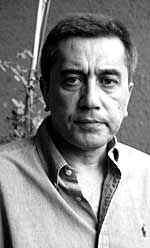
|
|
...Every time in history, artists have spoken of the beauty they have seen or have manifested their creativity in some form, we have been in awe of the immensity of their shared sense of beauty. The question is how and to what extent do our artists revere and pay homage to the wisdom of their predecessors.
For years the thought of gathering a collection, which truly demonstrated the essence of this country’s art and architecture, was brewing inside me. It was to be a collection that not only presented the visual beauty but also the origins of the creators’ thoughts. The beauty in our myths, legends and images have been more or less impressed by what has been in the past, and I hope to show how this process of imagination is crystallized in man’s creative mind, thus setting the grounds for the principles of art today.
This is an effort to introduce the forerunners in the field of culture, art and philosophy; it is also an inevitable need to reach out to the legacy of history. There will often be articles covering subjects such as: vast spaces stretching from the west to the east; the crystal clear springs and the expansive mirages; or it will be a perusal of the primeval arts expanding as far as the lost horizons of the world. We shall talk of the extravagant gilded ceilings and the elegantly symmetrical mud domes of the desert; we shall glance over inlaid work and printed calico and peer into post modernism or art deco. At times we will be traversing the desert as an endless journey to taste the fountains of Caroun and Jeyhoun rivers. Sometimes it will be diving deep into the art of the Renaissance or a search for the name of an unknown flower in the plains of Fars and Azerbaijan; or it may just be a little chat with an exhausted weaver and at the same time, a conversation with Matisse and Braque. We will peek at the mysterious spaces in the narrow dusty alleyways of Rey and Kashan and a word about the glorious palaces of the world. Yet, sometimes a divine silence embraces the Splendour and the allure of all the faith and the eye for beauty hidden under the golden domes of Isfahan and Ardastan, or Florence and Milan… And at the end it is to trust the beating hearts, full of secrets, hidden in a land of heroes, who watch over Iran’s blessed spirit of civilization.
This is how I am indebted to my country!
An encounter with the most influential aspects of Iranian identity, spending a few quiet moments with objects that are silent, yet express the hidden history of a three thousands year old civilization, is a beautiful and valuable experience. This was the stimulus for artistic creativity in the visual presentation of our national heritage. The present collection has therefore been designed according to standards slightly different from the conventional approaches of museums. The goal had been for the images to demonstrate both their artistic and visual aspects as well as their status as documents. Thus in completing the visual archives of the National Museum of Iran, the deciding factors were historic identity, uniqueness, archaeological prominence, aesthetic value and craftsmanship.
Selecting a space capable of presenting the objects as a collection, finding associations between the forms of objects of different eras, creating lighting effects that would set off the volume, texture and decorative design or text, and displaying the use of each object were the criteria applied in the photography. All images had been produced using large-format studio cameras; photographing 300 objects took seventeen months to complete. The history of each section was carefully studied before photography, and the image design was based on available data. Thus resulting exhibition is the product of eyes, minds and hands that cherish and honor the objects, their history and their homeland.
